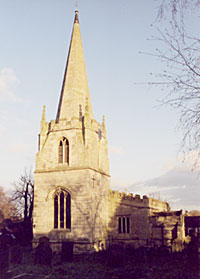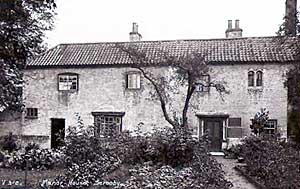
St Wilfrid's Church, Scrooby (A. Nicholson, 1999).
When the Insurrection, known as “the Pilgrimage of Grace,” took its rise, it was at Scrooby, on October 21st, 1536, that the Earl of Shrewsbury, Lord Steward of the King's Household, and Lieutenant-General from the Trent northward, was in anxious consultation with the Earls of Rutland and Huntingdon, concerning this Catholic Rebellion against enforced Protestantism; and it was from Scrooby that same day, they sent Thomas Myller, Lancaster Herald, as he himself tells us, “with a proclamation, to be read amongst the Traitors and rebellious persons assembled at Pomfret, contrary to the King’s laws.”
In 1541, John Leland says, “In the mene town of Scroby I markid 2 thinges, the paroche church, not bigge but very welle buildid ex lapido polite quadrato [out of stones neatly squared]; the second was a great manor place, standinge withyn a mote and buildid yn to courtes, whereof the first is very ample, and al buildid of tymbre, saving the front of the Haule, that is of bricke.”
With regard to the interior of the house, after their visitation of the province of York, Doctors Richard Layton and Thomas Legh presented their report to Cromwell. It contained an inventory of what was in the “dynyng chambre,” which was “ceiled and dressed with waynscot,” what was in the “wimpholler's chambre and the 4 oodre chambres above and beneath,” and so on through all the thirty-nine chambres and apartments, even “to the court between the galerie and the kitchen,” and including all the furniture, even to “the old tymbre of a shed over the well.” William Warener, the receiver, valued the rents of the Archbishop’s lordship of Scrooby at £167 11s.
1545. On 6th Feb., 36 Henry VIII., the Manor of Scrooby was alienated by the Archbishop to the King in fee, and so confirmed to him by the statute of 37 Hen. VIII., cap. 16.
King Henry VIII. slept a night at Scrooby, on his way to the north.
1593. In the remembrances of the Archbishop of York, touching the manors of .Southwell and Scrooby, is the following entry:—“For that of Scrooby only a rent of £40 is received whereas it is worth £170. In the manors are 32 towns, 5 parks, woods worth £5000, which it would undo the country to cut down, 1000 tenants, 2 pair houses, and so many leases falling in within 20 years that they will then be worth £1000 a year.”
Archbishop Edwyn Sandys made this palace his principal residence, and one of his great-grand-daughters is buried in Scrooby Church. His latter days were mostly passed at Southwell, for he had leased Scrooby manor, at a yearly rent of £65 6s. 8d., to his son, Sir Samuel Sandys, who subsequently granted it to his brother, Sir Martin Sandys.
We must now turn from the Archbishops of York, who allowed the palace, which was one of seven they had, to gradually fall into decay. It then became a royal post-house and inn for important travellers. The decay of the old house would of course be gradual, and Thoroton, speaking of it, says—“Here, within memory, stood a very fair palace, a far greater house of receit, and a better seat for provision than Southwell, and had attending to it, the North soke, consisting of very many towns thereabouts; it hath a fair park belonging to it. Archbishop Sandes caused it to be demised to his son, Sir Samuel Sands, since which the house hath been demolished almost to the ground. The church (a fair one, too, if not ruinous), is appropriated to the Archbishopric of York.”
The church described by Leland, is dedicated to St. Wilfred, and is an ancient embattled structure in the early English and Decorated styles, having a square tower surmounted by four pinnacles, and a lofty octagonal spire.
One of the bells is dated 1787, one l649, and another 1611, with “God our speed” upon it. The parish register commences 1695.
Near the north-east gate are the old vicarage, the parish pound, and all that remains of the parish stocks.

Old Manor House, Scrooby in the 1900s.
The site of the palace is now the home close of a farmhouse. There was a bridge and a gate-house at the entrance, and the area was walled round in brick.
We must now turn to an entirely different class of men, the Pilgrim Fathers of America, and the interest attaches, not so much to what took place at Scrooby, as to the fact that what did so take place was the beginning of great events.
These men went from the land of their fathers to a home in the wilderness, and devised the Constitution that laid the foundation and key-stone of American civil policy, which was copied in the formation of succeeding States. Eighty millions of people now live under principles laid down by the men who went from Scrooby.
William Brewster, “the Pilgrim Father,” was born, probably at Scrooby, about 1560 or 1564; he was for some years in the service of Mr. Davison, Secretary of State to Queen Elizabeth, and visited the Low Countries in the train of his patron, when he went as Royal Ambassador. He returned to Scrooby in 1587, after Davison’s downfall, and assisted his father, who held the position of “Post” on the Great North Road, and whom he shortly after (1589), succeeded. The salary was 20d. a day till July, 1603, when it was raised to 2 shillings. Every “Post” was required to keep, and have constantly ready, two horses at least, with suitable furniture; he was also to have at least two bags of leather, well lined with baize or cotton, and a horn for the driver to blow “as oft as he meets company,” or three times in every mile. After receiving the packet entrusted to him, the driver was to start within fifteen minutes, and to run in summer at the rate of seven miles an hour, in winter at the rate of five. In 1589 a charge was made of negligence in transmission; it appears from the Articles of Charges, that the 155 miles between Berwick and Newark took eighty-three hours to travel, the despatch in question left Doncaster at ij in the morning, and reached the post of Scrooby the same day at iiij in the morning, “so in riding seven miles ij hours, it came nearer the regulation pace.”
At Scrooby, the Separatist community ordinarily met at William Brewster’s house on the Lord's Day, and, to quote Bradford, “with great love he entertained them when they came, making provision for them, to his great charge.” Richard Clyfton became their pastor. Among the preachers to them were John Robinson, M.A., Richard Bernard, then vicar of Worksop, the author of a book which somewhat anticipated Bunyan’s “Holy War.” He further anticipated John Howard in his investigations as to prisons. Richard Clyfton, “a grave and fatherly old man, having a great white beard,” became the Rector of Babworth in 1586; and another preacher was John Smyth, once curate of Gainsborough. Tradition says that they worshipped in one of the out-buildings in Brewster’s house. In Brown’s “Pilgrim Fathers,” published by the Religious Tract Society, 1897, is a picture of the stable of the Scrooby Manor house, there stated to be the probable place of meeting in 1607. Mr. William Stevenson says—“In the bedroom at the south end, evidence of the old chapel is seen ; there is an aumbry in the east wall, and the lower half of the Gothic east window still exists;” this, he thinks, is no doubt the apartment wherein William Brewster, the minister, held his “unlawful conventicle.” “This identification of the old chapel,” he adds, “is not common knowledge.” The room, however, looks small for the purpose.
